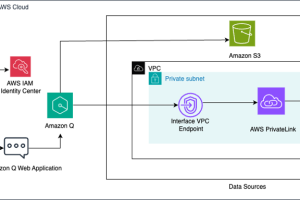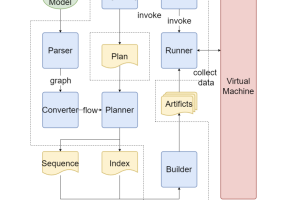Gradient boosting algorithms are powerful tools for prediction tasks, and CatBoost has gained popularity for its efficient handling of categorical data. This is especially valuable for the Ames Housing dataset, which contains numerous categorical features such as neighborhood, house style, and sale condition.
CatBoost excels with categorical features through its innovative “ordered target statistics” approach. Unlike traditional methods that require extensive preprocessing (like one-hot encoding), CatBoost can work directly with categorical variables. It calculates statistics on the target variable for each category, considering the ordering of examples to prevent overfitting.
In this post, we will explore CatBoost’s unique features, such as Symmetric Trees and Ordered Boosting, and compare different configurations. You’ll learn how to implement CatBoost for regression, prepare data effectively, and analyze feature importance. Whether you’re a data scientist or a real estate analyst, this post will help you understand and apply CatBoost to improve your prediction models.
Let’s get started.
CatBoost Essentials: Building Robust Home Price Prediction Systems
Photo by Kote Puerto. Some rights reserved.
Overview
This post is divided into five parts; they are:
- Installing CatBoost
- CatBoost’s Key Differentiators
- Overlapping Features with Other Boosting Algorithms
- Implementing CatBoost for Home Price Prediction
- CatBoost Feature Importance Analysis
Installing CatBoost
CatBoost (short for Categorical Boosting) is a machine learning algorithm that uses gradient boosting on decision trees. It was developed by Yandex, a Russian technology company, and is particularly effective for datasets with categorical features. CatBoost can be installed using the following command:
This command will download and install the CatBoost package along with its necessary dependencies.
CatBoost’s Key Differentiators
CatBoost stands out from other gradient boosting frameworks like Gradient Boosting Regressor, XGBoost, and LightGBM in several ways:
- Symmetric Trees: CatBoost builds symmetric trees, which can help in reducing overfitting and improving generalization.
- Ordered Boosting: An optional parameter in CatBoost that uses a permutation-driven alternative to the standard gradient boosting scheme.
Let’s dive deeper into these two unique features that set CatBoost apart from its competitors.
Symmetric Trees: Balancing Performance and Generalization
The use of Symmetric Trees is a key differentiator for CatBoost:
- Tree Structure: Unlike the potentially deep and unbalanced trees in other algorithms, CatBoost grows trees that are more balanced and symmetric.
- How it Works:
- Enforces a more even split of data at each node.
- Limits the depth of trees while maintaining their predictive power.
- Advantages:
- Reduced Overfitting: The balanced structure prevents the creation of overly specific branches.
- Improved Generalization: Symmetric trees tend to perform better on unseen data.
- Enhanced Interpretability: More balanced trees are often easier to understand and explain.
- Comparison: While other algorithms like Gradient Boosting Regressor, XGBoost, and LightGBM typically use depth-wise or leaf-wise growth strategies that can result in asymmetric trees, CatBoost stands alone in its commitment to symmetric tree structures.
Ordered Boosting: An Optional Approach to Gradient Boosting
Ordered Boosting is an optional parameter in CatBoost, designed to address target leakage:
- The Problem: In traditional gradient boosting, the model calculates gradients for all instances simultaneously, which can lead to a subtle form of overfitting.
- CatBoost’s Solution:
- Creates multiple random permutations of the dataset.
- For each instance, it calculates the gradient using only the preceding instances in the permutation.
- Builds multiple models, one for each permutation, and then combines them.
- Potential Benefits:
- Reduced Overfitting: By using different permutations, the model is less likely to memorize specific patterns.
- More Stable Predictions: Less sensitive to the specific order of the training data.
It’s important to note that while Ordered Boosting is a unique feature of CatBoost, it’s an optional parameter and not the default setting.
Overlapping Features with Other Boosting Algorithms
While Ordered Boosting and Symmetric Trees are unique to CatBoost, it shares some advanced features with other gradient boosting frameworks:
Automatic Handling of Categorical Features
- CatBoost and LightGBM can work with categorical features directly without requiring pre-processing steps like one-hot encoding.
- XGBoost has recently added experimental support for categorical features.
- GBR (Gradient Boosting Regressor) typically requires manual encoding of categorical variables.
This feature is particularly beneficial for our home price prediction task, as real estate data often includes numerous categorical variables.
GPU Acceleration
- CatBoost, XGBoost, and LightGBM all offer native GPU support for faster training on large datasets.
- The standard GBR implementation in scikit-learn does not provide GPU acceleration.
GPU acceleration can significantly speed up the training process, especially when dealing with large housing datasets or when performing extensive hyperparameter tuning.
Implementing CatBoost for Home Price Prediction
After exploring CatBoost’s unique features, let’s put them into practice using the Ames Housing dataset. We’ll implement both the default CatBoost model and one with Ordered Boosting to compare their performance.
|
1 2 3 4 5 6 7 8 9 10 11 12 13 14 15 16 17 18 19 20 21 22 23 24 25 26 27 28 |
# Import libraries to run CatBoost Regressor import pandas as pd from catboost import CatBoostRegressor from sklearn.model_selection import cross_val_score
# Load dataset data = pd.read_csv(‘Ames.csv’) X = data.drop([‘SalePrice’], axis=1) y = data[‘SalePrice’]
# Identify and fill NaNs in categorical columns cat_features = [col for col in X.columns if X[col].dtype == ‘object’] X[‘Electrical’] = X[‘Electrical’].fillna(X[‘Electrical’].mode()[0]) X[cat_features] = X[cat_features].fillna(‘Missing’)
# Identify categorical columns cat_features = X.select_dtypes(include=[‘object’]).columns.tolist()
# Define and train the default CatBoost model default_model = CatBoostRegressor(cat_features=cat_features, random_state=42, verbose=0) default_scores = cross_val_score(default_model, X, y, cv=5, scoring=‘r2’) print(f“Average R² score for default CatBoost: {default_scores.mean():.4f}”)
# Define and train the CatBoost model with Ordered Boosting ordered_model = CatBoostRegressor(cat_features=cat_features, random_state=42, boosting_type=‘Ordered’, verbose=0) ordered_scores = cross_val_score(ordered_model, X, y, cv=5, scoring=‘r2’) print(f“Average R² score for CatBoost with Ordered Boosting: {ordered_scores.mean():.4f}”) |
Let’s break down the key points of this implementation:
- Data Preparation: We load the Ames Housing dataset and separate the features (X) from the target variable (y). We identify categorical columns and fill any missing values. For the ‘Electrical’ column, we use the mode (most frequent value). For all other categorical columns, we fill missing values with the string ‘Missing’. This step is necessary because CatBoost doesn’t handle
np.nanvalues well in categorical features. Explicit handling of missing values, as we’ve done here, ensures that all categorical values are valid strings. It’s worth noting that CatBoost can handle missing values (np.nan) in numerical features without any such amendment, demonstrating different behaviors for categorical and numerical missing data. - Specifying Categorical Features: We explicitly tell CatBoost which columns are categorical using the
cat_featuresparameter. This is an important step as it allows CatBoost to apply its special handling of categorical variables. - Model Training and Evaluation: We create two CatBoost models – one with default settings and another with Ordered Boosting. Both models are evaluated using 5-fold cross-validation.
The results of running this code are:
|
Average R² score for default CatBoost: 0.9310 Average R² score for CatBoost with Ordered Boosting: 0.9182 |
The default CatBoost model outperforms the Ordered Boosting variant on this dataset. The default model achieves an impressive R² score of 0.9310, explaining about 93.1% of the variance in home prices. The Ordered Boosting model, while still performing well with an R² score of 0.9182, doesn’t quite match the default model’s performance.
This outcome highlights an important point: while Ordered Boosting is an innovative feature designed to reduce target leakage, it may not always lead to better performance. The effectiveness of Ordered Boosting can depend on the specific characteristics of the dataset and the nature of the prediction task.
In our case, the default CatBoost settings seem to be well-suited for the Ames Housing dataset. This underscores the importance of experimenting with different model configurations and not assuming that more complex or innovative approaches will always yield better results.
CatBoost Feature Importance Analysis
In this section, we take a closer look at our default CatBoost model to understand which features are most influential in predicting home prices. By employing a robust cross-validation approach, we can reliably identify the top predictors while mitigating the risk of overfitting to any particular data split:
|
1 2 3 4 5 6 7 8 9 10 11 12 13 14 15 16 17 18 19 20 21 22 23 24 25 26 27 28 29 30 31 32 33 34 35 36 37 38 39 40 41 42 43 44 45 46 47 48 49 50 51 52 53 54 |
# Build on block of code above to extract Feature Importance import numpy as np import seaborn as sns import matplotlib.pyplot as plt from catboost import CatBoostRegressor from sklearn.model_selection import KFold
# Set up K-fold cross-validation kf = KFold(n_splits=5) feature_importances = []
# Iterate over each split for train_index, test_index in kf.split(X): X_train, X_test = X.iloc[train_index], X.iloc[test_index] y_train, y_test = y.iloc[train_index], y.iloc[test_index]
# Train default CatBoost model model = CatBoostRegressor(cat_features=cat_features, random_state=42, verbose=0) model.fit(X_train, y_train) feature_importances.append(model.get_feature_importance())
# Average feature importance across all folds avg_importance = np.mean(feature_importances, axis=0)
# Convert to DataFrame feat_imp_df = pd.DataFrame({‘Feature’: X.columns, ‘Importance’: avg_importance})
# Sort and take the top 20 features top_features = feat_imp_df.sort_values(by=‘Importance’, ascending=False).head(20)
# Set the style and color palette sns.set_style(“whitegrid”) palette = sns.color_palette(“rocket”, len(top_features))
# Create the plot plt.figure(figsize=(12, 10)) ax = sns.barplot(x=‘Importance’, y=‘Feature’, data=top_features, palette=palette)
# Customize the plot plt.title(‘Top 20 Most Important Features – CatBoost Model’, fontsize=20, fontweight=‘bold’) plt.xlabel(‘Importance Score’, fontsize=15) plt.ylabel(‘Features’, fontsize=15)
# Add value labels to the end of each bar for i, v in enumerate(top_features[‘Importance’]): ax.text(v + 0.01, i, f‘{v:.2f}’, va=‘center’, fontsize=13)
# Extend x-axis by 10% and feature names font size plt.xlim(0, max(top_features[‘Importance’]) * 1.1) plt.yticks(fontsize=13)
# Adjust layout and display plt.tight_layout() plt.show() |
Our analysis uses 5-fold cross-validation to ensure the stability and reliability of our feature importance rankings.
 Looking at the visualization, we can draw several important insights:
Looking at the visualization, we can draw several important insights:
- Top Predictors: The two most important features by a significant margin are ‘GrLivArea’ (Ground Living Area) and ‘OverallQual’ (Overall Quality). This suggests that the size of the living area and the overall quality of the home are the strongest predictors of price in our model.
- Neighborhood Matters: ‘Neighborhood’ ranks as the third most important feature, highlighting the significant impact of location on home prices.
- Size and Quality Dominate: Many of the top features relate to the size (e.g., ‘TotalBsmtSF’, ‘1stFlrSF’) or quality (e.g., ‘ExterQual’, ‘KitchenQual’) of different aspects of the home.
- Basement Features: Several basement-related features (‘BsmtFinSF1’, ‘TotalBsmtSF’, ‘BsmtQual’) appear in the top 10, indicating the importance of basement characteristics in determining home value.
- External Factors: Features like ‘ExterQual’ (Exterior Quality) and ‘LotArea’ also play significant roles, showing that both the quality of the house’s exterior and the size of the lot contribute to the price.
- Age Matters, But Not As Much: ‘YearBuilt’ appears in the top 20, but its relatively lower importance suggests that other factors often outweigh the age of the home in determining its price.
By leveraging these insights, real estate market stakeholders can make more informed decisions about property valuation, home improvements, and investment strategies.
Further Reading
Tutorials
Ames Housing Dataset & Data Dictionary
Summary
In this blog post, we explored CatBoost, a powerful gradient boosting library, and applied it to the task of home price prediction using the Ames Housing dataset. We highlighted CatBoost’s unique features, including Symmetric Trees and Ordered Boosting. Through practical implementation, we demonstrated how to use CatBoost for regression tasks and analyzed feature importance to gain insights into the factors that most significantly influence home prices.
Specifically, you learned:
- Default vs Advanced Configurations in CatBoost: While CatBoost offers advanced features like Ordered Boosting, our results demonstrated that simpler configurations (like the default settings) can sometimes outperform more complex ones. This highlights the importance of experimentation and not assuming that more advanced techniques will always yield better results.
- Data Preparation for CatBoost: We discussed the importance of proper data preparation for CatBoost, including handling categorical features and missing values. CatBoost doesn’t handle
np.nanvalues well in categorical columns, necessitating string conversion or explicit missing value handling. - Robust Feature Importance Analysis: We employed a 5-fold cross-validation approach to calculate feature importance, ensuring a stable and reliable ranking of influential features. This method provides a more robust estimate of feature importance compared to a single train-test split, accounting for variability across different subsets of the data.
Do you have any questions? Please ask your questions in the comments below, and I will do my best to answer.











